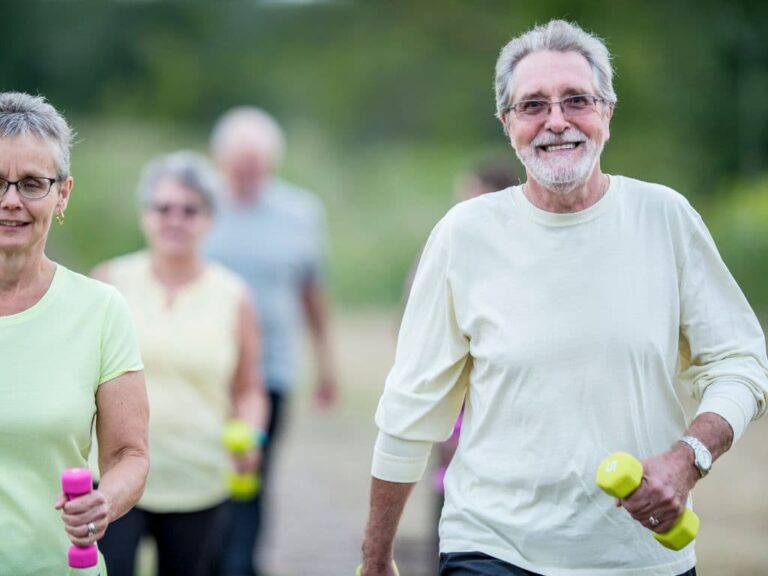How Long Does It Take to See Results From Walking?
Walking is one of the most accessible and popular forms of exercise worldwide. Requiring little equipment and able to be done almost anywhere, walking offers a range of benefits for both physical and mental health. But how long does it actually take to experience these benefits and see meaningful results from a walking regimen?
The time it takes to see results from walking varies, but most people begin to feel increased energy, better sleep, and reduced stress within 1-4 weeks. Improvements in cardiovascular health can occur around 6-8 weeks of regular brisk walking. Visible changes in body shape and weight loss typically become apparent after 8-12 weeks of consistent walking activity.
The time it takes to see results will vary from person to person depending on factors like fitness level, intensity, and consistency. However, incorporating walking into your daily routine and sticking to it can lead to noticeable changes within weeks or months. Read on to learn more about what to expect and how to get the most out of walking for your health.

How Long Does It Take to See Results From Walking?
The duration it takes to see benefits from walking depends on several key factors:
Fitness Level – Those newer to exercise will see faster initial progress as their body adapts to increased activity. People who are already active may need to walk longer or increase intensity to continue improving fitness.
Frequency – Walking more days per week will lead to faster results. Experts recommend 150 minutes per week of moderate activity like brisk walking.
Intensity – Walking at a brisk pace where you can still hold a conversation leads to greater calorie burn and cardiorespiratory benefits. Adding hills or intervals can further boost intensity.
Consistency – Regular walking is key. Sporadic workouts spread out over longer periods won’t have the same cumulative effects. Sticking to a routine matters.
Taking these factors into account, most people begin to feel results in 1-4 weeks through increased energy, better sleep, reduced stress and other mental boosts.
Improvements to cardiovascular health can occur in around 6-8 weeks of regular brisk walking. And noticeable changes in body shape and weight lossmay become apparent in 8-12 weeks.
Here is a table summarizing how long it takes to see results from walking:
| Result | Time Frame |
|---|---|
| Increased energy and reduced stress | 1-4 weeks |
| Improved cardiovascular health | 6-8 weeks |
| Changes in body shape and weight loss | 8-12 weeks |
| Potential weight loss of 1-2 lbs per month | Walking 150+ minutes per week |
| Lower blood pressure and cholesterol | 2-3 months |
| Stronger leg and core muscles | 2-3 months |
| Improved bone density | 4-6 months |
| Sustained weight loss | 6-12 months |
How Long Does It Take to See Weight Loss Results From Walking?
Walking is an effective form of calorie-burning exercise that can contribute to weight and fat loss over time. To see these results, experts recommend brisk walking for at least 150 minutes per week, which can amount to 30 minutes per day, 5 days a week.
At this amount, walkers can expect to burn around 300 extra calories per day, leading to potential weight loss of 1-2 pounds per month. More brisk walking can lead to faster weight loss, along with monitoring nutrition intake.
Consistency over months and years is key for sustaining weight loss through a walking regimen. So be patient and focus on building a habit around daily movement.
What Is the Best Way to Incorporate Walking Into Your Daily Routine?
Creating a sustainable walking routine requires finding ways to fit it into your regular schedule. Consider these tips:
- Schedule specific times for walks so they become ingrained habits. Calendar them like appointments.
- Walk before or after work to bookmark your day with movement.
- Take walking breaks during long days in the office to refresh.
- Walk during lunch breaks or on work calls when possible.
- Take the stairs instead of the elevator whenever you can.
- Park farther away from destinations to increase walking distance.
- Walk kids to school if driving them.
- Set step goals and use a fitness tracker to stay motivated.
Finding opportunities like these to walk each day makes it easier to reach recommended weekly minutes. The best time of day to walk is when you can be most consistent. Morning and evenings tend to work well.
What Are the Benefits of Walking?
Regular walking delivers a wide spectrum of physical and mental health benefits:
Improves cardiovascular health – Walking gets the heart pumping and is linked to decreased risk of high blood pressure, heart disease and stroke.
Supports weight loss – Brisk walking burns calories and the regular exercise can aid long-term fat loss and maintenance.
Builds stronger bones – Walking provides weight-bearing exercise that helps improve bone mineral density over time.
Boosts energy levels – Physical activity like walking improves blood flow and oxygen circulation, combating fatigue.
Enhances mood – Walking outside exposes you to sunlight and releases feel-good endorphins. It reduces anxiety and improves sleep.
Eases joint pain – The smooth action of walking causes little impact on joints compared to other exercises.
In addition to these whole-body improvements, walking remains accessible at any age and fitness level, making it sustainable long-term. And it gets you outside and moving, which we all need more of.
How Can You Make Your Walks More Enjoyable and Motivating?
For walking to provide maximum benefits, it needs to be an activity you look forward to each day. Here are tips for making it more fun:
- Vary your routes to prevent boredom and take in new scenery. Explore different neighborhoods or trails.
- Listen to audiobooks, podcasts or motivating music while you walk to make the time pass quickly.
- Walk with a friend, family member or dog for companionship and added safety.
- Track your progress with goals for distance or step count to see your improvements.
- Focus on your surroundings and enjoy being outdoors and detached from technology and stressors.
- End each walk with a rewarding treat, like a piece of fruit or a few minutes to relax.
Having accountability through fitness devices or walking buddies along with small rewards help incentivize you to stick to the routine, even on days you may not feel like it.
Are There Different Types of Walking Workouts?
For added variety, there are a few different walking workout formats to choose from:
Leisurely stroll – A light to moderate pace that allows for conversation. Lower intensity but can build endurance over longer distances.
Power walk – Brisk pace just below jogging speed with arms driving forcefully. Makes a great cardio workout.
Hill intervals – Alternate short bursts of fast uphill walking with recovery on flatter terrain. An intense calorie burner.
Backwards and sideways – Walking in different directions engages new muscles while preventing repetitive strain.
Rucking – Hiking with a weighted rucksack for added resistance and to build full-body strength.
Picking the style that best matches your current fitness, goals and interests will make your walking regimen more dynamic while providing targeted benefits. Mixing it up keeps exercise engaging long-term.
Are There Risks Associated With Excessive Walking?
While a regular walking routine comes with many benefits, overdoing it can present a few potential downsides to consider:
- Injury risk rises when rapidly increasing walking mileage and intensity without proper rest and recovery. Progress gradually.
- Walking too many consecutive days without rest can lead to overuse injuries in feet, ankles, knees, hips and back. Take at least 1-2 rest days per week.
- Dehydration and nutritional deficiencies may occur from an extreme high volume of walking without proper fueling. Drink plenty of fluids and eat a balanced diet.
- Be mindful of unsafe walking conditions like extreme weather, darkness or heavily trafficked roads which increase accident risk.
With moderation and smart nutrition and recovery habits, walking poses very few risks and remains one of the safest, most accessible activities. Listen to your body’s limits.
Conclusion
Making walking a daily habit requires dedication but offers manifold benefits for mental and physical wellbeing. While results require consistency over months, you can expect to feel positive effects in energy, mood and sleep patterns within weeks of starting a routine. Visible fitness improvements and weight loss often emerge around 8-12 weeks.
Maximize your results by walking briskly at least 30 minutes per day, 5 days per week. Find creative ways to fit walking into your existing schedule and change up your routes and workouts to prevent boredom. Stick with it by recruiting walking partners for accountability and support.
The key is consistency. Make walking a regular non-negotiable part of your day, and it will rewards you for the long-term with better health.
Frequently Asked Questions
-
How long does it take to see results from walking?
You will see a difference in the fit and space of your clothes after 3-4 days walking. Real changes begin after 7 days of walking! Your body has used fat to fuel your energy, which is called fat burning! You feel toned and stronger muscles!
-
What is the healthiest form of exercise?
Walking. It is easy and powerful to walk. Walking can improve your health, reduce cholesterol, increase bone strength, lower blood pressure, boost your mood and decrease your chances of getting a variety of diseases like diabetes and heart disease.
-
What hair Colour makes you look younger?
Honey, strawberry, copper and gold give us a youthful glow. Lighter shades can also help to distract the eyes from skin concerns.
-
What exercise should a 70 year old man do?
Adults 65 years and over need to exercise at least 150 minutes per week. This could be 30 minutes each day or 5 days a weeks of moderate activity like walking. They also need to do 75 minutes per week of intense activity like running, jogging or hiking. A minimum of 2 days per week should be spent engaging in activities that help strengthen the muscles.
-
What time should seniors go to bed?
For seniors 65 and older to feel alert and rested, they need at least 7-8 hours sleep per night.
-
Can you regain muscle mass after 70?
Seniors can still bulk up on muscle by pressing iron. As we age, our muscle mass drops at astonishing rates. Researchers found that lifting weights can help people over 50 not only preserve but even increase muscle mass.
-
What is considered a sedentary lifestyle?
Sedentary lifestyle or one that is inactive. These phrases are common and all refer to the same thing. A lifestyle that involves a lot sitting or lying down and little exercise. People are increasingly spending less time exercising and sitting in the United States.
-
Is walking 2 miles a day enough exercise?
Walking 2 miles per day may help to burn calories, improve overall health and reduce stress, but building long-lasting, sustainable habits must be the top priority.
-
Is just walking enough exercise?
Is walking enough to be healthy? Short answer: Yes. According to Laura Goldberg MD, University Hospitals pediatric sport medicine specialist, walking is as effective as any form of exercise. Guidelines are to do 150 minutes of moderate exercise per week and 75 minutes of vigorous activities each day.
-
What is beauty sleep?
Although it may seem like an outdated cliché, getting your beauty sleep is actually quite possible. Beauty sleep refers to the way our skin and bodies begin to heal themselves from the day. Deep sleep induces the body to enter a recovery mode, producing growth hormones.






